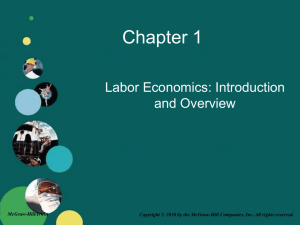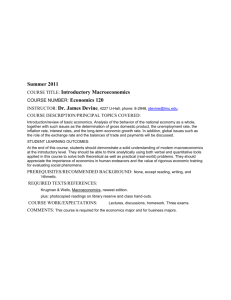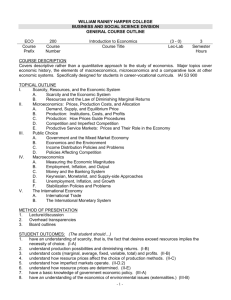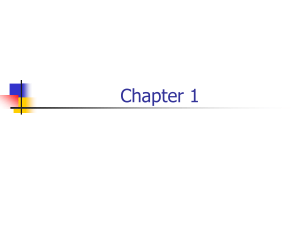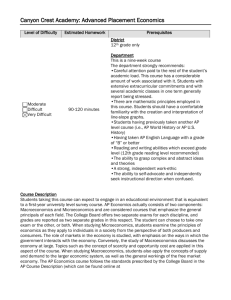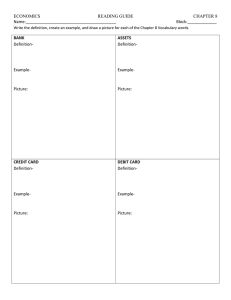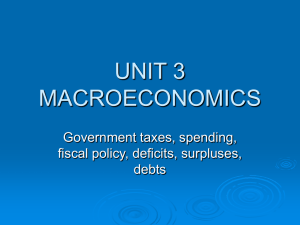Ch. 5 PPT
advertisement
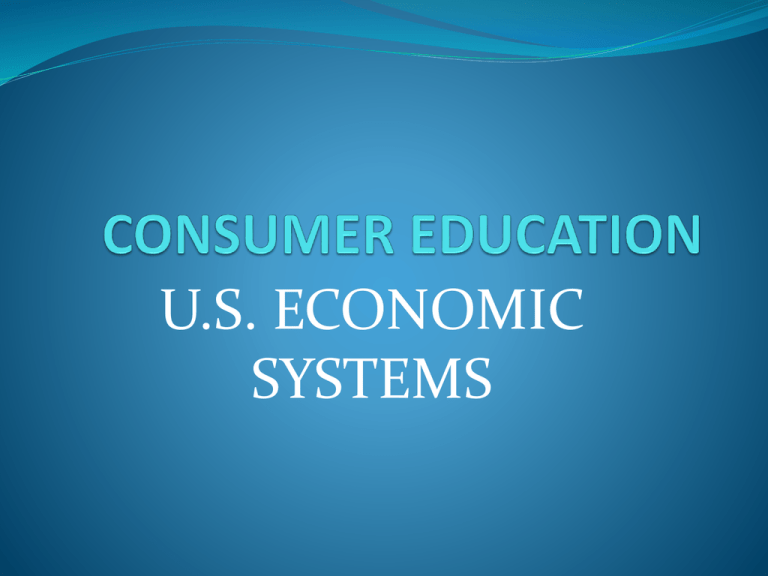
U.S. ECONOMIC SYSTEMS Economics Chapter 5 Why is economics important ? 1. AFFECTS YOUR DAILY LIVES 2. HELPS YOU MAKE MORE INFORMED DECISIONS 3.MAKES YOU A MORE EFFECTIVE CITIZEN Economics Chapter 5 What is economics? Social science that examines how society uses scarce resources to produce and distribute goods and services that satisfy people’s wants and needs MICROECONOMICS MACROECONOMICS Microeconomics - is the branch of economics that examines the choices of individuals concerning one product, one firm, or one industry. Macroeconomics - the branch of economics that examines the behavior of the whole economy at once. Economic Systems Economic system - the combination of social and individual decision making a society uses to answer the three economic questions Basic Economic Problem Scarcity-the condition that occurs because people’s wants and needs are unlimited. Unlimited wants and needs is the human characteristics of never having all wants and needs satisfied. Opportunity Costs and Benefits Opportunity cost - value of any alternative that you must give up when you make a choice. Opportunity benefit - what is gained by making a particular choice. When you make an informed choice, you compare the benefit with the cost. Economic Systems 4 Basic types of economic systems Traditional-Traditional customs and beliefs People hunt, fish, farm and provide shelter as their ancestors did Economic Systems Command – decisions are made by a central government Government leaders control all economic resources Known as-Communism Market Economy -What to produce is decided by individual consumers and producers. Individuals and private companies control economic recourses Known as Capitalism Mixed - mix of command and market economic systems. The idea of free market is combined with some degree of government control Economic System Goals 1. Growth- increase the amount of goods and services produced over time 2. Efficiency-wise use of limited resources 3. Stability-steady level of economic well-being no extreme ups or downs 4. Justice- a system that treats all citizens fairly 5. Security-support system for citizens who face economic hardships Fundamental characteristics include: 1. Private property- individuals allowed to own economic resources 2. Freedom of Choice- consumers freely choose how to spend their money Freedom of Enterprise-individuals are free to own and control business enterprises Limited government control-free to operate with a minimum of government interference Factors of Production all the economic resources necessary to produce a society’s goods and services 1. Land-natural resources and the raw materials they provide 2. Labor- human resources, the contributions of all workers 3. Capital- machines and technology used in the production of goods and services 4. Entrepreneurship- those willing to own their own businesses Productivity- a measure of the efficiency with which goods and services can be produced Increased by-the use of technology, education and training of the workforce Business Classifications 1. proprietorships-owned or controlled by one person Estimates are that 80% of all businesses are proprietorships 2. Partnerships- a firm owned by two or more people 3. Corporations-an organization that is owned by many but treated by law as a single entity separate from owners Shareholders- people who have purchased shares of stock, which are units of ownership in the company Demand-is the quantity of a particular good or service that consumers are willing and able to buy at a given price Law of Demand- Price of product goes up/Demand goes down Price falls/demand rises Supply-quantity of a particular product that producers are willing and able to make available for sale. Law of Supply-when price of a product goes up/supply goes up Price goes down/supply goes down Why? Equilibrium price-the price where consumers are willing to buy the exact quantity producers are willing to make Labor unions-organization that represents workers for the purpose of bringing about better pay and working conditions Do they work? Collective bargaining-unions and employers negotiate an employment contract addressing issues such as pay, benefits, job security etc. Competition-rivalry between two or more businesses, each trying to gain a larger share of the market Chapter 5 Section 3 Levels of Government 1. Federal-deals with matters that affect the country as a whole 2. State-Concerned with laws within its boundary's Local-cities and towns Try to meet the needs of its citizens Government 4 roles: 1. provide public goods and services 2. regulate economic activity 3. redistribute income 4. ensure economic stability Social security-an insurance program that is sponsored by the federal government and pays benefits to qualified people. Paid for by a tax on earnings Retirement- when you reach a certain age and retire, workers who have paid Social Security taxes become eligible to receive benefits Survivor’s-when insured worker dies, the surviving spouse and children (under 18) are paid benefits to replace lost income Disability-workers who develop physical or mental conditions that prevent them from working may receive benefits Medicare- program that pays some of the cost of medical and hospital care for people who are 65 and older. Federal Assistance programs Food stamps-unemployed, public assistance, homeless or low income may qualify to receive assistance to purchase food. Regulating Economic Activity Monopoly-a situation in which a single company controls the supply of goods or services for which there is no close substitute Good/Bad Why Antitrust laws- designed to regulate unfair business practices that reduce competition. Examples- Mergers Why would some mergers be looked at by the government Fiscal policy-approach by government to maintain economic stability by making adjustments to policies dealing with taxing and spending Monetary policy- involves regulating interest rates and money supply Example- the raising or lowering of prime rate Excise tax-tax on the manufacturing or sale of certain goods and services. It is included in the price paid by consumers Examples-gas, tires, firearms, tobacco are just a few Estate tax- based on the value of a person’s property after his/her death, if the value exceeds a certain dollar amount, (Illinois, 2013 4 million) Gift tax- may be charged to someone who gives a gift exceeding a certain dollar amount Benefit principle-those who benefit from a public service (roads, police, fire etc) should pay for it. Ability to pay principle- more taxes should be paid by people who can afford to pay more. Influences how tax rates are set Proportional tax- takes the same percentage out of everyone's income 9% out of $25,000 0r 9% out of 100, 000 This is very much like the flat tax all the political candidates refer too. Arguments of against flat tax Progressive tax-takes a larger percentage of the income of highincome people than low income people. The federal income tax is progressive Regressive tax-takes larger percentage of the income of low income people than high income people Example- two families buy $8000 dollars in groceries in a year to feed their families Tax rate 5% which equals $400.00 1.6%/25,000 0.4%/100,000



